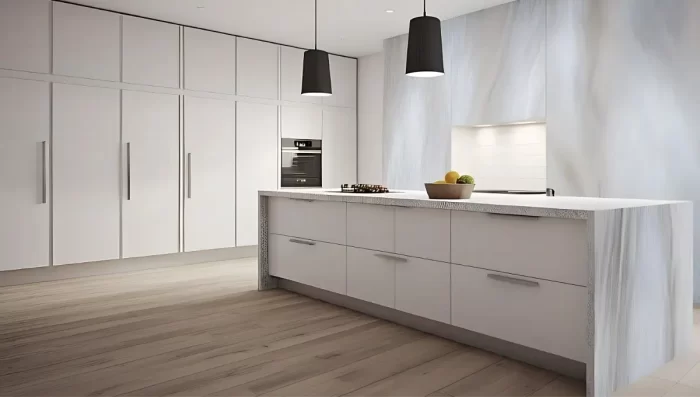So, picture this: a countertop that doesn’t just stop at the edge—it keeps going down the side like a mini waterfall. Ta-da! That’s a waterfall edge countertop.
It’s like your kitchen’s wearing a long, fancy dress.
Let’s dive in and find out why people are flipping pancakes and flipping out over this super-stylish kitchen trend!
- What Is a Waterfall Edge?
- What Does “Waterfall” Mean?
- Why Do People Love Waterfall Edge Countertops?
- Waterfall Edge Countertop Materials You Can Choose
- Where to Put a Waterfall Countertop in Your House?
- Waterfall Edge vs Regular Countertop: What’s the Big Deal?
- How Much Does a Waterfall Edge Countertop Cost?
- Waterfall Edge Countertops: Pros & Cons
- How to Clean a Waterfall Countertop?
- Mistakes to Avoid with Waterfall Countertops
- Matching Waterfall Edges with Kitchen Cabinets
- Best Colors and Styles for Waterfall Countertops
- Are Waterfall Countertops Just a Trend or Here to Stay?
- Final Thought on Waterfall Edge Countertops:
- FAQs about waterfall edge countertop
What Is a Waterfall Edge?
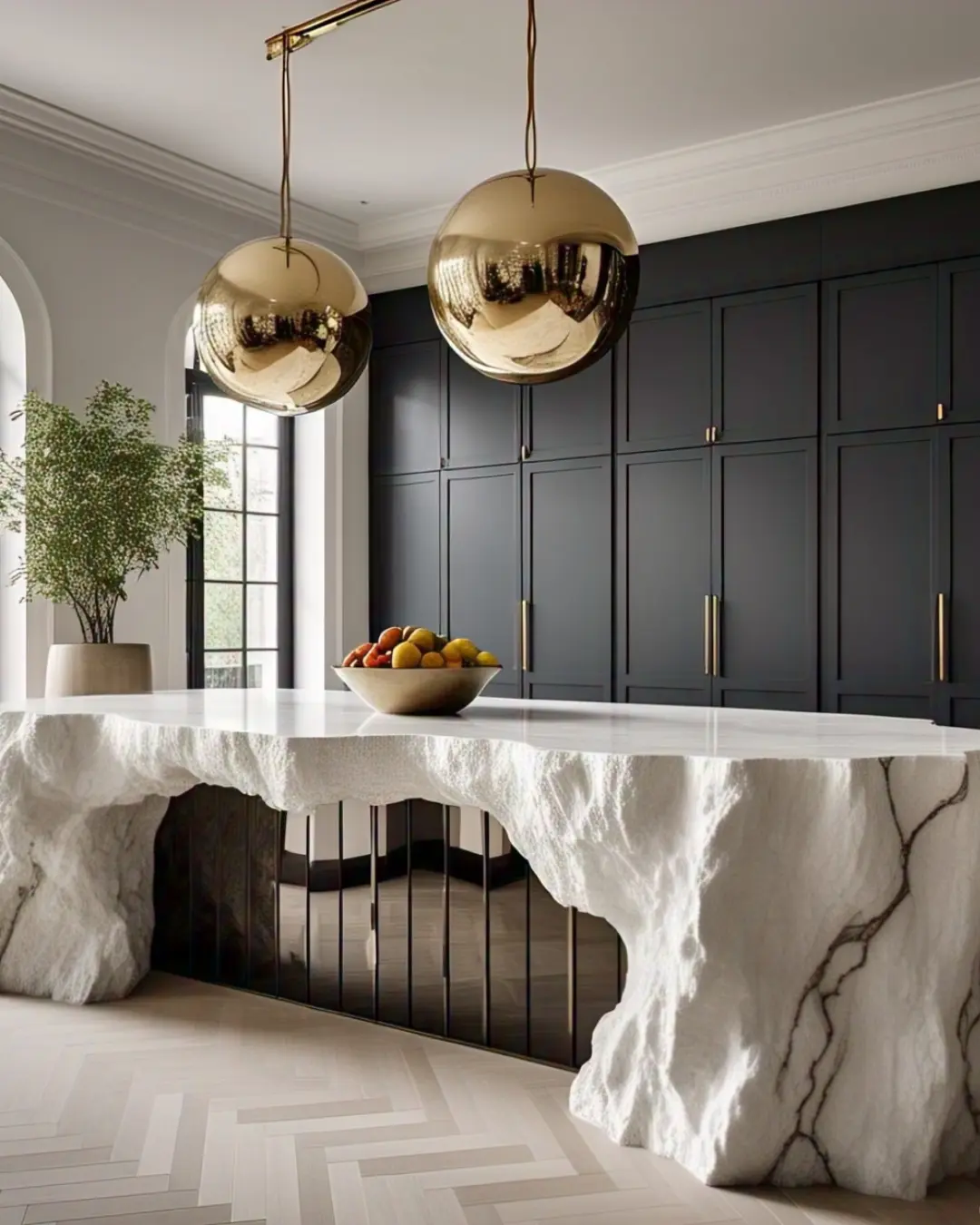
Imagine your countertop jumping off the cliff… but instead of crashing, it gracefully turns 90° and runs all the way to the floor. That’s a waterfall edge!
- Looks like: A countertop wearing a stone cape
- Feels like: Running your hand down a smooth slide
- Costs like: “Maybe I should skip avocado toast for a month” (it’s fancy!)
Related: Types of Countertop Edges
What Does “Waterfall” Mean?
A “waterfall” edge means the countertop material flows vertically down the sides of an island or cabinet, creating a seamless 90° drop, like a frozen waterfall. It turns ordinary counters into dramatic design statements with clean, modern lines.
Why Do People Love Waterfall Edge Countertops?
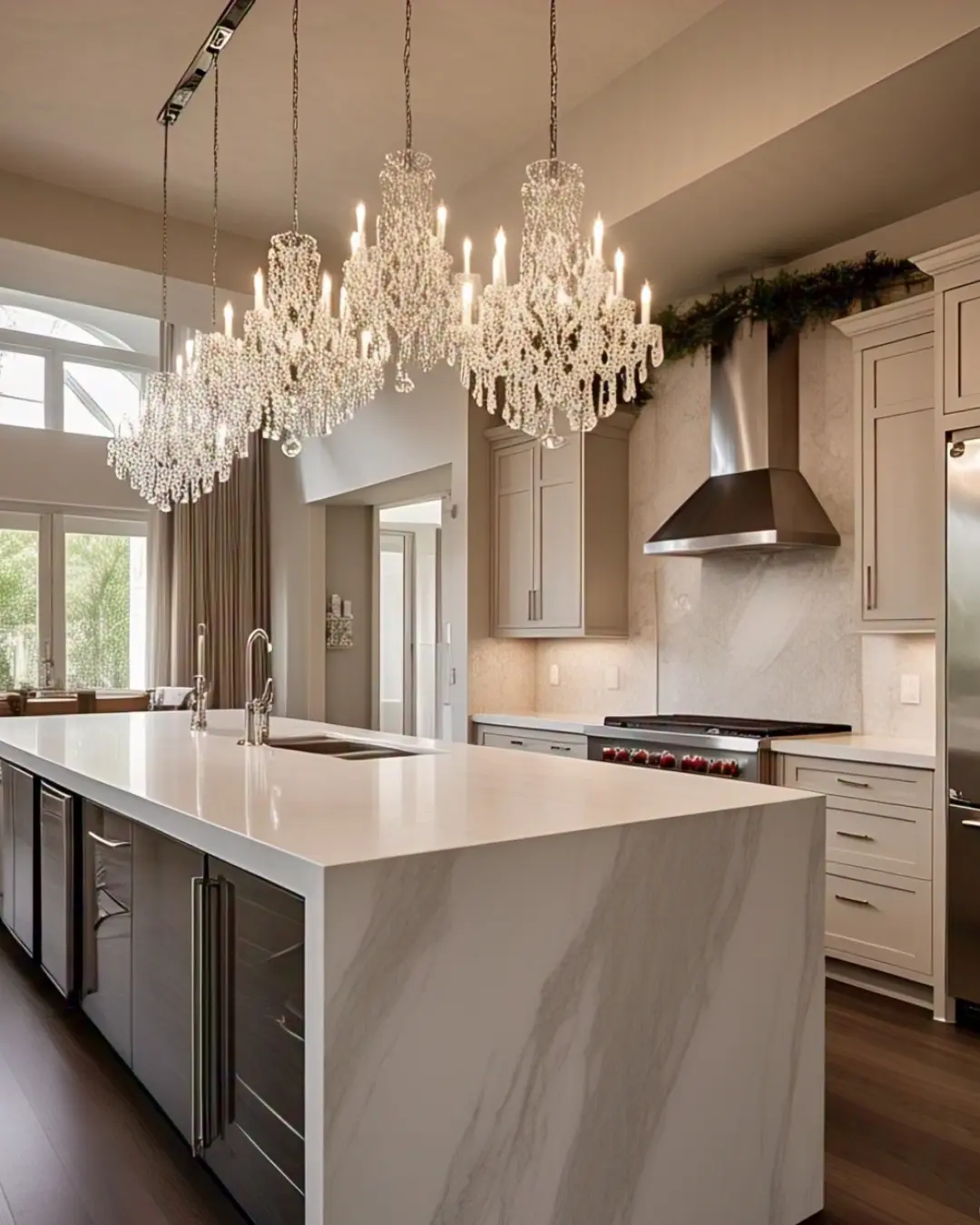
Waterfall edge countertops are the ultimate kitchen flex—they turn boring islands into jaw-dropping showstoppers with their sleek, stone “cape” flowing all the way to the floor.
People love them because they make even basic kitchens look stupidly fancy (like you hired a celebrity designer, when really you just splurged on the counter).
They’re also secretly practical—hiding crumbs, adding storage, and surviving kids better than your last phone screen. Sure, they cost more than a straight edge, but hey, you can’t put a price on making guests whisper, “Whoa, is that marble?!”
Basically, if your kitchen were a superhero, waterfall edges would be its dramatic cape. 😎
Waterfall Edge Countertop Materials You Can Choose
So many options! It’s like picking your favorite ice cream flavor (but for your house).
🍦 Natural Stone (Granite/Marble)
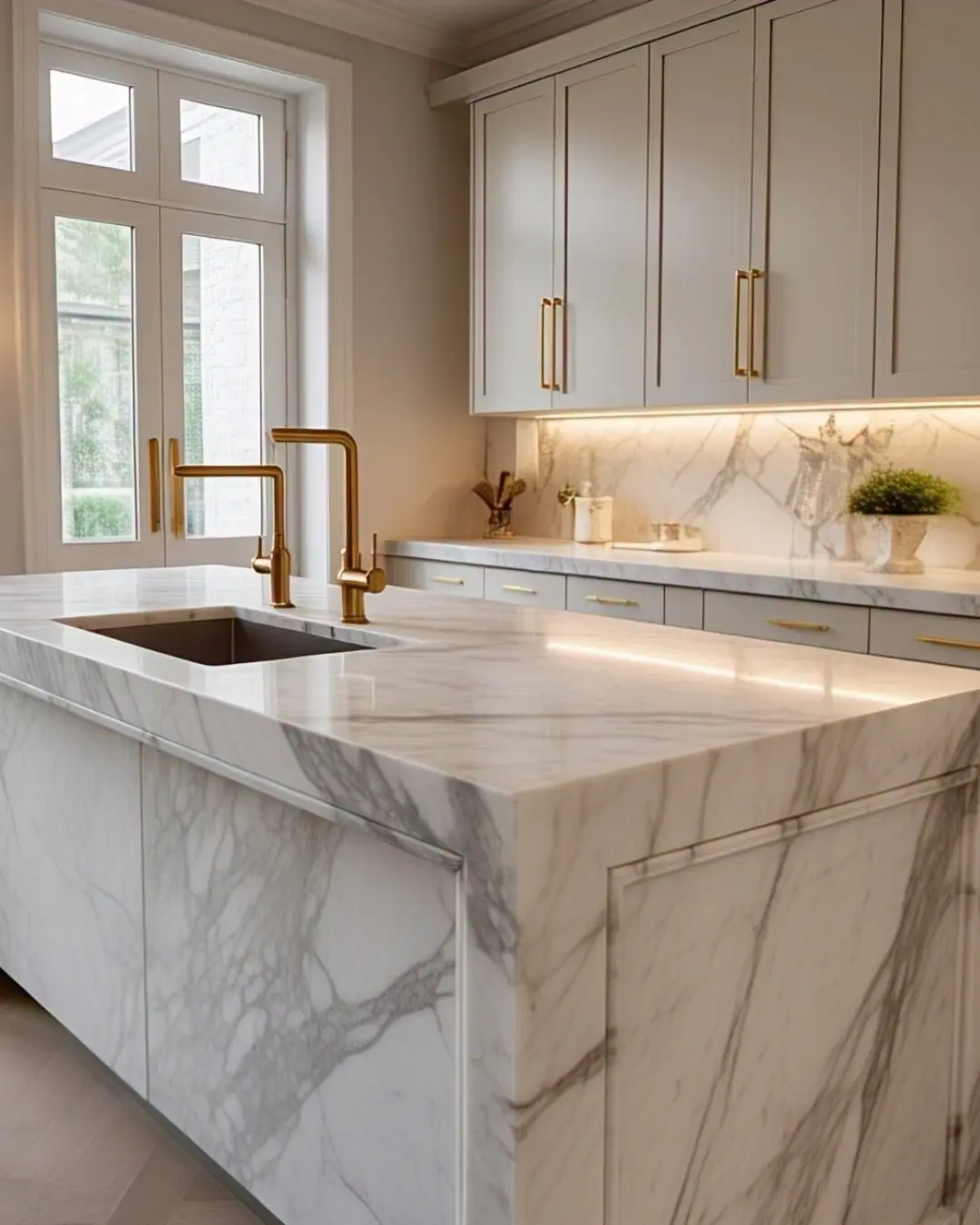
✔ Why?
- Stunning natural patterns – Each slab is a one-of-a-kind masterpiece
- Heat-resistant – Perfect for bakers and pizza addicts
⚠ Watch Out:
- Marble stains (RIP, red wine spills)
- Needs yearly sealing (granite) or weekly prayers (marble)
🍫 Concrete (Industrial Chic)
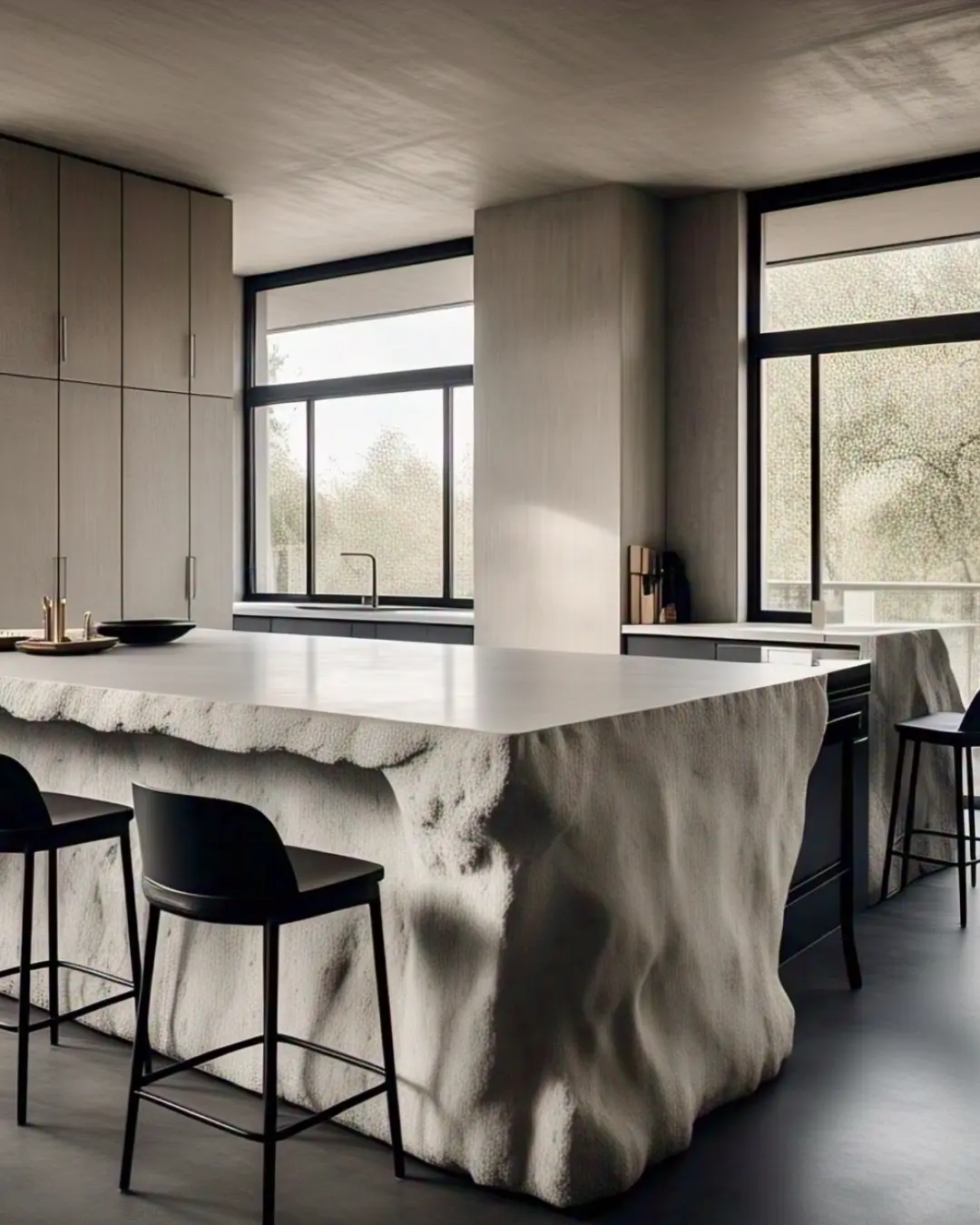
✔ Why?
- Custom shapes – Perfect for curved waterfalls!
- Modern look – Feels like a fancy loft
⚠ Watch Out:
- Can crack – Not great for earthquake areas
- Needs sealing
🍓 Quartz Queen
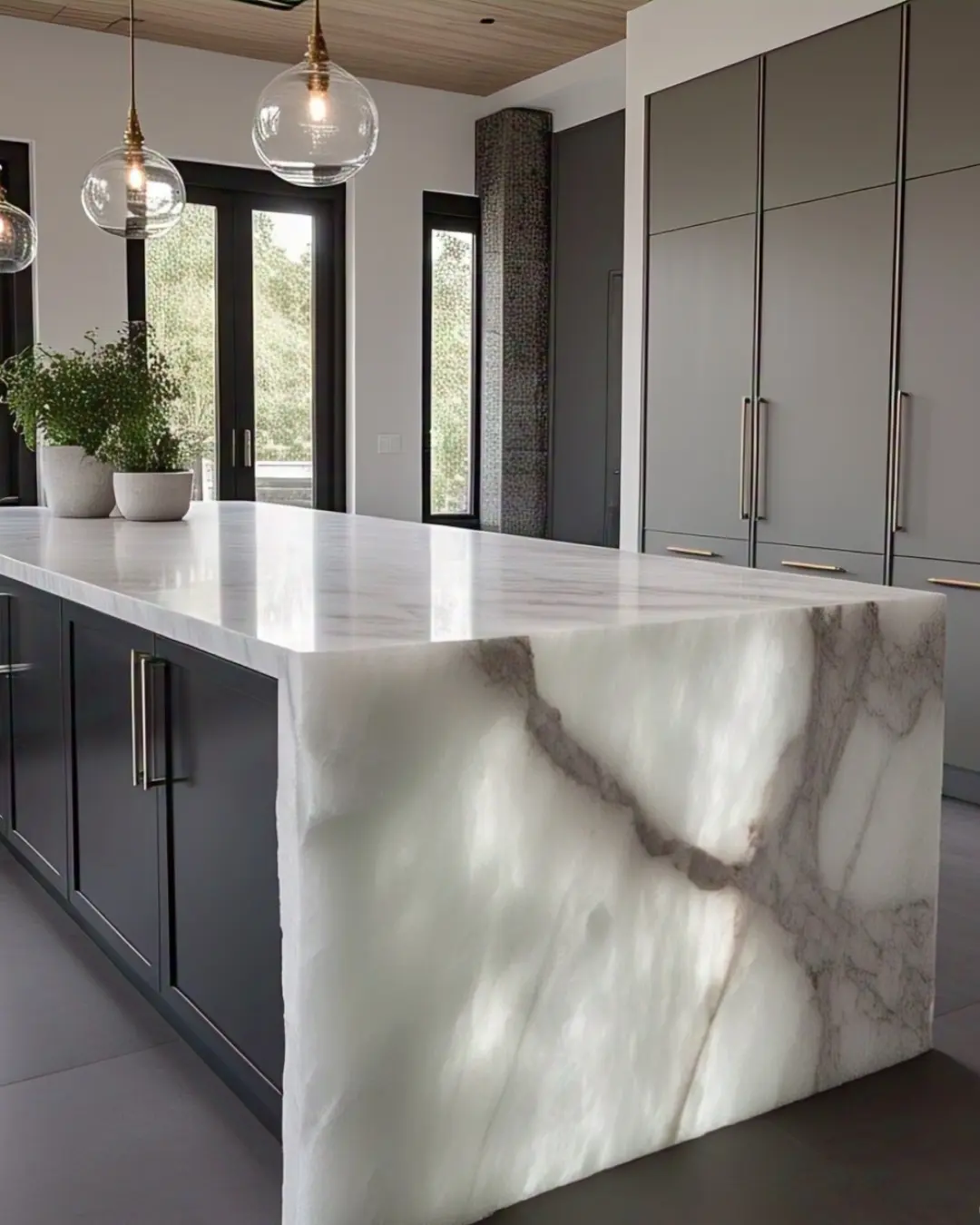
✔ Why?
- Super tough – Won’t chip or crack easily
- No sealing needed – Spills wipe right off
- Looks perfect – Seams are nearly invisible
⚠ Watch Out:
- Not heatproof – Use trivets for hot pans!
🌿 Unique Pick: Butcher Block
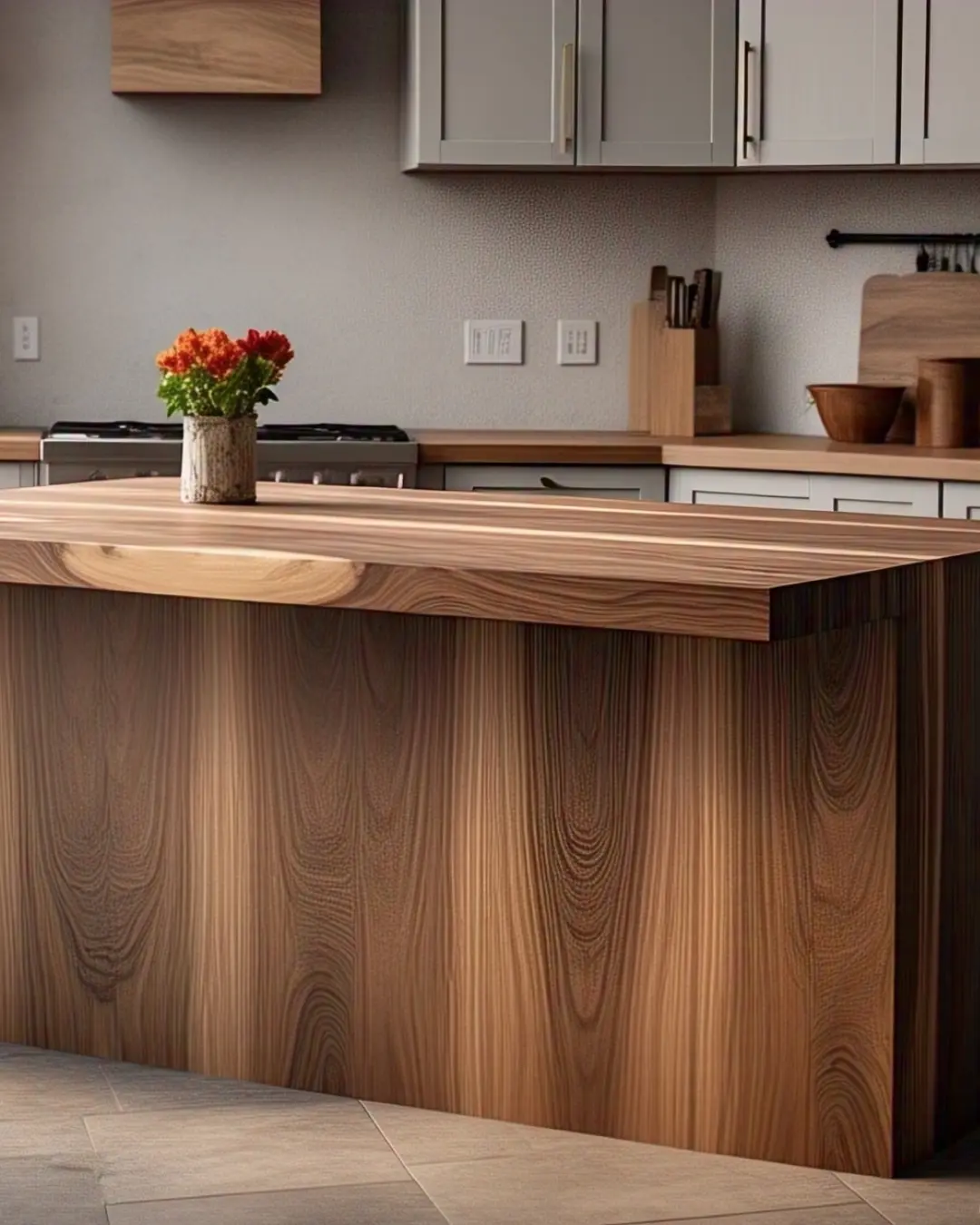
✔ Why?
- Warm and cozy – Great for farmhouses
- Can sand out scratches
⚠ Watch Out:
- Water damage risk – No wet glasses!
- Needs oiling
💰 Budget Option: Laminate
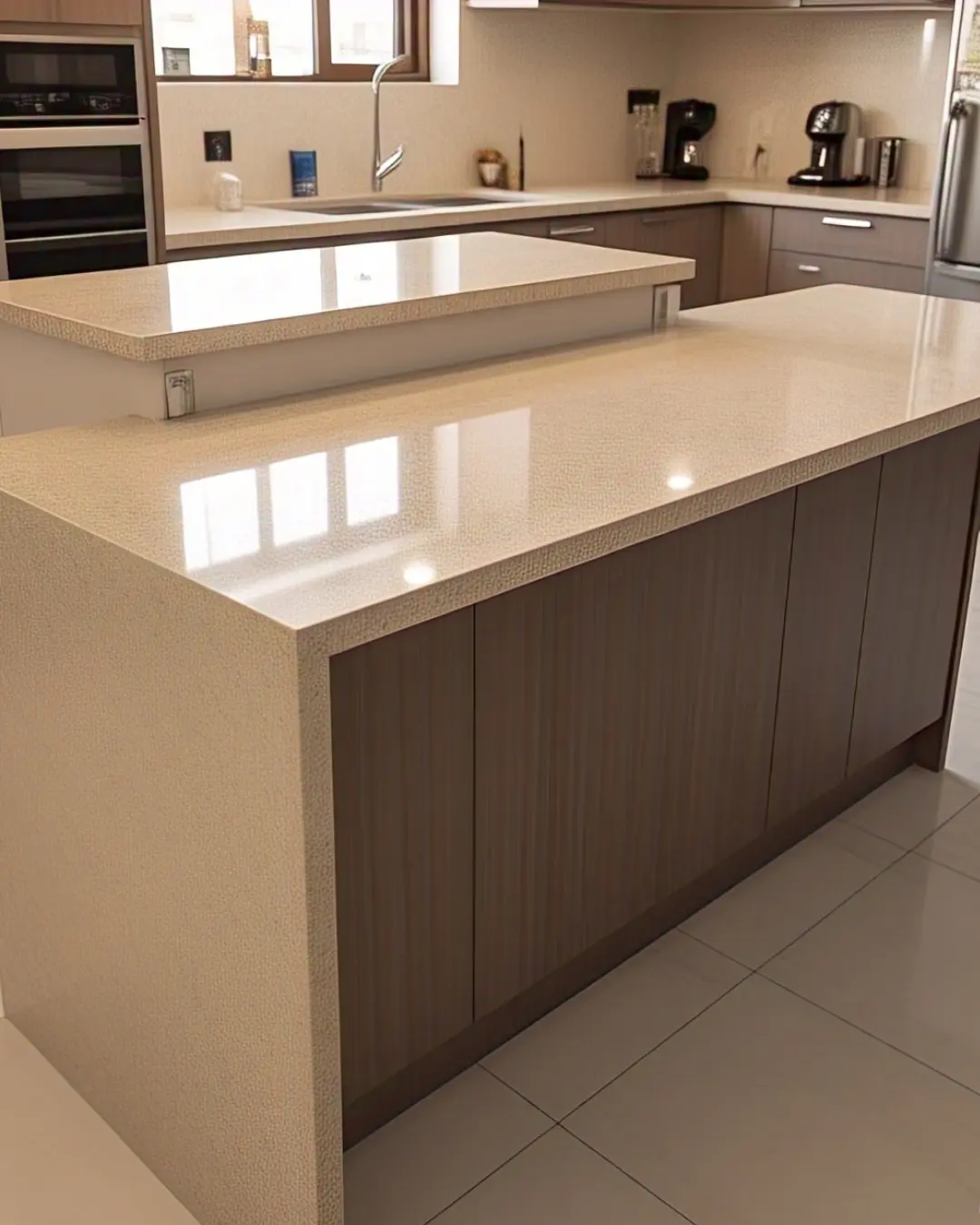
✔ Why?
- Cheapest way to get the look
- New patterns (even faux marble/wood!)
⚠ Watch Out:
- Seams show more
- Not as durable
❌ Materials to Avoid
🚫 Granite – Too heavy, may crack at seams
🚫 Thin Porcelain – Too brittle for tall waterfalls
Pro Tip: Love marble but hate stains? Try quartz that looks like marble!
Where to Put a Waterfall Countertop in Your House?
Waterfall edges make a bold statement, but they work best in certain spots. Here’s where to (and not to) use them:
1. Kitchen Islands (#1 Spot!)
✔ Why? Turns your island into a showstopping centerpiece
✔ Pro Tip: Add LED lighting inside the waterfall for a glow effect!
2. Kitchen Peninsulas
✔ Why? Gives a “floating” look to open-concept kitchens
✔ Smart Move: Use the waterfall side as a breakfast bar with stools
3. Bar Areas (Wet or Dry)
✔ Why? Makes even a small home bar feel luxury hotel-worthy
4. Bathroom Vanities (For Spa Vibes)
✔ Why? Creates a high-end boutique hotel look
✔ Best Material: Quartz (handles humidity better than wood)
5. Freestanding Desks (Home Offices)
✔ Why? Makes your workspace look custom-designed
✔ Fun Twist: Try a wooden waterfall desk for warmth
🚫 Where to Avoid Waterfall Edges
❌ Small Galley Kitchens – Overwhelms tight spaces
❌ Low-Budget Projects – Cheaper materials show seams badly
❌ Kid’s Craft Rooms – Prone to dings and marker stains
💡 Clever Compromises
- “Half Waterfall” – Only cover one side of the island
- “Fake Waterfall” – Use thin veneers (budget-friendly)
- “Floating Shelf” Look – Stop the waterfall 12″ above the floor
Waterfall Edge vs Regular Countertop: What’s the Big Deal?
| Feature | Regular Countertop | Waterfall Edge Countertop |
|---|---|---|
| Style | Plain Jane | Fashion Queen |
| Coverage | Just the top | Top + side |
| Price | Less | More |
| Durability | Good | Great |
How Much Does a Waterfall Edge Countertop Cost?
A waterfall edge adds luxury drama to your kitchen or bathroom—but that sleek look comes with a price tag. Here’s the real deal on costs:
💰 Price Breakdown (Per Linear Foot)
| Material | Standard Edge Cost | + Waterfall Edge Cost | Why? |
|---|---|---|---|
| Quartz | $70–$150/sq ft | +$300–$800 (per side) | Extra material + precise seams |
| Marble | $100–$250/sq ft | +$500–$1,200 | Harder to match veining |
| Concrete | $80–$200/sq ft | +$400–$900 | Custom mold required |
| Laminate | $30–$80/sq ft | +$150–$400 | Seams more visible |
| Butcher Block | $50–$120/sq ft | +$200–$600 | Risk of wood warping |
Note: Prices vary by location and installer.
📉 What Makes It Expensive?
- Extra Material – You’re basically adding a second countertop vertically.
- Precision Work – Seams must be perfect (or it looks cheap).
- Labor – Takes 2-3x longer to install than a regular edge.
💡 3 Ways to Save Money
- Do Just One Side – Only waterfall on the visible side of your island.
- Pick Quartz Over Marble – Easier seams = lower labor costs.
- Skip the Base Cabinets – Let the waterfall “float” (saves on materials).
🤔 Is It Worth It?
✅ YES if:
- Your island is the star of your kitchen
- You love high-end design (and will keep it 10+ years)
- You’re already splurging on countertops
❌ NO if:
- You’re on a tight budget (regular edges save $$$)
- Your kitchen is small (can feel overwhelming)
Waterfall Edge Countertops: Pros & Cons
✅ Benefits (Why People Love Them)
✔ Luxury Look – Instantly makes your kitchen look high-end (like a designer showroom).
✔ Hides Cabinets – Covers the sides of islands, so you don’t see ugly cabinet ends.
✔ Durable Corners – No exposed edges to chip or wear down over time.
✔ Space Enhancer – Makes small islands look bigger and more expensive.
✔ Customizable – Works with LED lighting, different materials, and finishes.
❌ Downsides (What to Watch For)
✖ Expensive – Adds $300–$1,200+ per side (extra material + labor).
✖ Seam Risks – Poor installation = visible glue lines or gaps.
✖ Not for Small Kitchens – Can overwhelm tight spaces.
✖ Hard to Replace – Changing it later means redoing the whole counter.
✖ Limited Materials – Laminate & granite often look cheap as waterfalls.
How to Clean a Waterfall Countertop?
- Daily Wipe-Down
- Use warm water + mild soap and a microfiber cloth (no harsh scrubbers!).
- Wipe top-to-bottom to follow the waterfall flow.
- Seam Care
- Gently clean seams with a soft-bristle toothbrush (crumbs love hiding there!).
- Avoid bleach—it can eat away at adhesive.
- Stain Solutions
- Quartz/Stone: Baking soda paste + water (let sit 5 mins, then wipe).
- Laminate: Magic Eraser (lightly!).
- Protect the Shine
- Marble/Granite: Reseal every 6–12 months.
- Quartz: Just soap and water—no sealing needed!
- Avoid Disaster
- ❌ Steel wool
- ❌ Vinegar/acidic cleaners
- ❌ Dragging heavy pots across edges
Mistakes to Avoid with Waterfall Countertops
Here are some “oops” moments to dodge:
- ❌ Choosing the wrong material (not all can be used for waterfall edges)
- ❌ Ignoring your kitchen layout
- ❌ Forgetting about weight (they can be heavy!)
Matching Waterfall Edges with Kitchen Cabinets
Match the style, baby!
- White cabinets + Marble waterfall = Clean and crisp
- Dark wood cabinets + Granite waterfall = Rich and warm
- Matte black cabinets + Quartz waterfall = Chic and modern
Make sure everything flows like, well… a waterfall!
Best Colors and Styles for Waterfall Countertops
Want your kitchen to pop? Try:
- White with gray veining – classy and elegant
- Bold black granite – dramatic and powerful
- Light wood grain quartz – airy and minimal
Are Waterfall Countertops Just a Trend or Here to Stay?
They’ve been around for a while and don’t seem to be going anywhere.
Why? Because they:
- Look amazing
- They are easy to clean
- Add value to your home
That’s not a fad. That’s just smart!
Final Thought on Waterfall Edge Countertops:
Waterfall edges deliver showstopping luxury—perfect for modern kitchens where the island is the star. They add sleek drama, hide cabinet sides, and protect edges from chips.
But they’re not for everyone: the extra cost (20-40% more than standard edges) and space demands make them best for open, high-end designs. If you love clean lines and have the budget, it’s a timeless upgrade.
If you prefer cozy or budget-friendly spaces, a simpler edge might be smarter. Tip: Splurge on just one waterfall side to save money while keeping the wow factor! 🌊✨
FAQs about waterfall edge countertop
Is a waterfall edge countertop kid-friendly?
Yep! Just make sure the edges are rounded a bit so no one bumps into sharp corners.
Can I install a waterfall edge on an old counter?
Usually not. You’ll need new material cut to size. But hey, new is fun!
What if it chips or cracks?
If you choose quartz or granite, it’s super strong. But if something does happen, call a countertop pro.
Will it match my farmhouse kitchen?
Absolutely! Choose a warm wood or soft stone, and it’ll blend right in.
How long does installation take?
Usually 1–2 days, depending on your setup and the installer.
Also, don’t forget to update your home with house making ideas. Let us make your home look beautiful.
